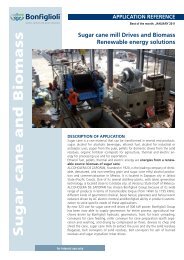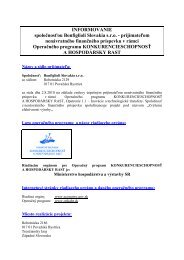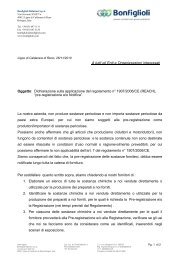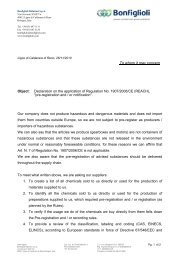Annual Report 2009 UK - Bonfiglioli
Annual Report 2009 UK - Bonfiglioli
Annual Report 2009 UK - Bonfiglioli
You also want an ePaper? Increase the reach of your titles
YUMPU automatically turns print PDFs into web optimized ePapers that Google loves.
Management <strong>Report</strong><br />
The United States GDP during the fourth quarter of <strong>2009</strong> rose by 5.6 from 2.2 in the previous quarter<br />
(both at an annual rate). The acceleration is more or less attributable entirely to the dynamism of<br />
stocks as both private consumption and foreign trade have had a limited impact on the dynamism of<br />
the GDP. The year <strong>2009</strong> closed with a negative growth rate on the USA GDP of -2.4%.<br />
Even in the United Kingdom the decline in economic activity slowed during the fourth quarter of<br />
<strong>2009</strong> after six consecutive quarters of negative rates. At the end of <strong>2009</strong> the negative growth of<br />
British GDP settled at -4.9% (+0.5 at the end of 2008).<br />
In Japan the economy in <strong>2009</strong> recorded a reduction in GDP growth of -5.2% (-1.2% at the end of<br />
2008).<br />
The fall in world demand and the reduced flow of foreign capital slowed down the main emerging<br />
economies, whose expansion rates in some cases took a downward turn (Russia and Brazil). The<br />
growth rates in China (+8.7%) and India (+5.7%) remained positive in <strong>2009</strong> however.<br />
During the first quarter of 2010 global recovery is picking up speed. The reconstitution of stocks will<br />
continue to provide a stronger boost in all areas, hand in hand with consumption, though in a less<br />
uniform manner (stronger in emerging economies). In some countries the conditions required to start<br />
the investments cycle for machinery are being created. The manufacturing sector, the most affected by<br />
the crisis, is now the driving force: the relevant indexes have reached the highest multi-year figures (in<br />
April in the Euro area 61.3, the highest in nearly 10 years); services are tagging along and are picking<br />
up speed. The Italian economy is still giving contradictory signals (as shown by the drop in turnover<br />
and orders), but is latching onto reawakening foreign demand: export is livelier, industrial production<br />
is increasing especially in the current quarter. GDP growth, taking into account the likely rise in esti-<br />
mates for the last quarter of <strong>2009</strong>, will be much higher than expected. The level of activity in Italy is<br />
however still quite low forcing companies to resort to the Layoff Benefits Fund. In general, the labour<br />
market is still weak, which penalises the confidence and spending of families. There remain extremely<br />
fragile elements making the global scenario uncertain. Firstly, in the financial system where indictment<br />
of Goldman Sachs pairs with the case of Greece highlighting questions remaining unresolved. Inte-<br />
rest rates will continue to be kept low. All the more so that, energy and food aside, retail prices are<br />
sluggish. In the meantime increases in raw materials crush margins recorded by businesses and the<br />
purchasing power of families. The exchange rates of Asian currencies will tend to appreciate following<br />
the revaluation of the Chinese Yuan recently announced. The International Monetary Fund (IMF) has<br />
estimated a 4.2% growth in the global economy for 2010, forecasting an additional + 4.3% for 2011.<br />
29<br />
<strong>Annual</strong> <strong>Report</strong> <strong>2009</strong>
















